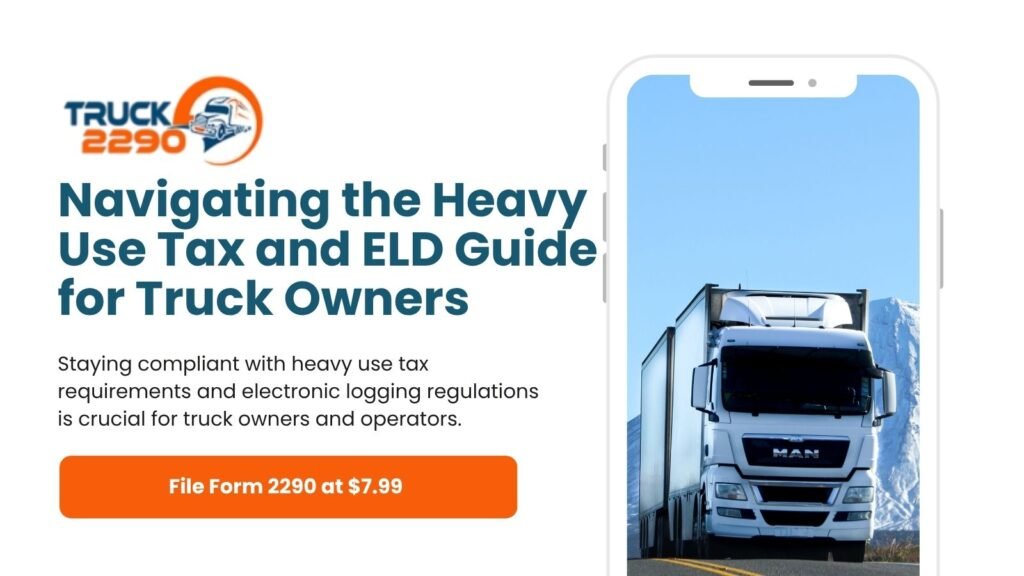As a truck owner or operator, staying compliant with heavy-use tax requirements and the ELD Guide for Truck owners is crucial. This article will guide you through understanding Form 2290, the filing and payment process, calculating the heavy-use tax, and the importance of electronic logging devices (ELDs) for trucks.

Table of Contents
Understanding Form 2290
What is Form 2290?
Form 2290, also known as the Heavy Vehicle Use Tax (HVUT) form, is a tax form required by the IRS for vehicles that weigh 55,000 pounds or more and travel on public highways. This tax helps fund highway maintenance and construction.
2290 Form Due Date
The due date for filing Form 2290 is generally August 31st each year. If you put a vehicle into service after July, the due date is the last day of the month following the month you first used the vehicle on public highways. For example, if you start using a truck in January, the due date is the end of February.
2290 Credit Instructions
You can claim a credit if you overpaid your heavy vehicle use tax. For example, if you sold or destroyed your vehicle during the tax period, you might be eligible for a refund. The IRS provides specific 2290 credit instructions on their website, guiding you through the process step-by-step.
Filing and Payment Process
How to File Form 2290?
Filing Form 2290 is straightforward if you follow these steps:
- Gather Information: Collect your vehicle identification number (VIN), taxable gross weight, and other required details.
- Complete the Form: Fill out Form 2290 with accurate information. You can download the form from the IRS website.
- Pay the Tax: Calculate the tax you owe based on your vehicle’s weight and miles driven. You can pay electronically or by check.
- Submit the Form: You can file electronically using the IRS e-file system or by mailing the completed form to the IRS.
2290 Proof of Payment
After filing and paying the tax, you will receive a stamped Schedule 1 as your 2290 proof of payment. This document is crucial for registering your vehicle with your state DMV and record-keeping.
How Do I Get a Copy of My Paid 2290?
If you need a copy of your paid Form 2290, follow these steps:
- Log into your IRS account: If you filed electronically, you could access your account online.
- Request a Copy: You can request a copy by calling the IRS directly or by using their online services.
- Check Your Records: If you filed by mail, keep copies of all forms and receipts.
Calculating the Heavy Use Tax
Form 2290 Tax Calculator
To determine how much tax you owe, you can use a Form 2290 tax calculator. This tool considers your vehicle’s weight, the number of miles driven, and other factors. The IRS website offers a free calculator to help you with this.
Common Mistakes in Tax Calculation
Avoid common mistakes when calculating your heavy-use tax:
- Incorrect Vehicle Weight: Make sure you enter the correct taxable gross weight.
- Overlooking Suspended Vehicles: Vehicles that travel less than 5,000 miles (7,500 for agricultural vehicles) are exempt from the tax, but you must still file Form 2290.
- Miscalculating Mileage: Keep accurate records of miles driven to ensure correct tax calculations.
ELD Guide for Truck Owners
Electronic Logging Devices (ELDs) are essential for modern truck operations. These devices automatically record driving time and help ensure compliance with hours-of-service (HOS) regulations set by the Federal Motor Carrier Safety Administration (FMCSA).
Benefits of ELD Devices
Using ELD devices for trucks offers several benefits:
- Accuracy: ELDs provide precise records of driving hours, reducing the risk of errors.
- Compliance: They help you comply with HOS regulations, avoiding fines and penalties.
- Efficiency: ELDs streamline record-keeping, saving time and reducing paperwork.
Electronic Logs for Trucks
Electronic logs, generated by ELDs, are digital records of a driver’s hours of service. These logs include information such as driving time, rest periods, and total hours worked. They are essential for compliance with FMCSA regulations and can be easily accessed during inspections.
Integration of Tax Compliance and ELDs
Streamlining Tax Filing with ELD Data
ELD data can be invaluable when filing your heavy use tax. By accurately recording your vehicle’s mileage, ELDs provide precise information that you can use to calculate your heavy use tax accurately. This integration ensures that you are paying the correct amount and helps prevent overpayment or underpayment.
Best Practices for Maintaining Compliance
To stay compliant with both tax and logging regulations, follow these best practices:
- Regularly Update ELD Software: Keep your ELD devices up-to-date with the latest software to ensure accurate data recording.
- Maintain Accurate Records: Keep detailed records of your vehicle’s mileage, weight, and maintenance.
- Review IRS Guidelines: Stay informed about any changes in IRS guidelines or tax rates for heavy vehicles.
- Use Reliable Tax Calculators: Utilize trusted Form 2290 tax calculators to ensure accurate tax calculations.
Conclusion
Staying compliant with heavy use tax requirements and electronic logging regulations is crucial for truck owners and operators. Understanding Form 2290, knowing the filing and payment process, accurately calculating the heavy-use tax, and using ELD devices for trucks are essential steps in maintaining compliance.
By following this guide, you can ensure that you meet all requirements, avoid penalties, and keep your operations running smoothly. Remember to regularly check for updates on IRS guidelines and FMCSA regulations to stay informed and compliant.
References
For more information on Form 2290, tax calculators, ELD devices, and compliance guidelines, visit the following resources:
